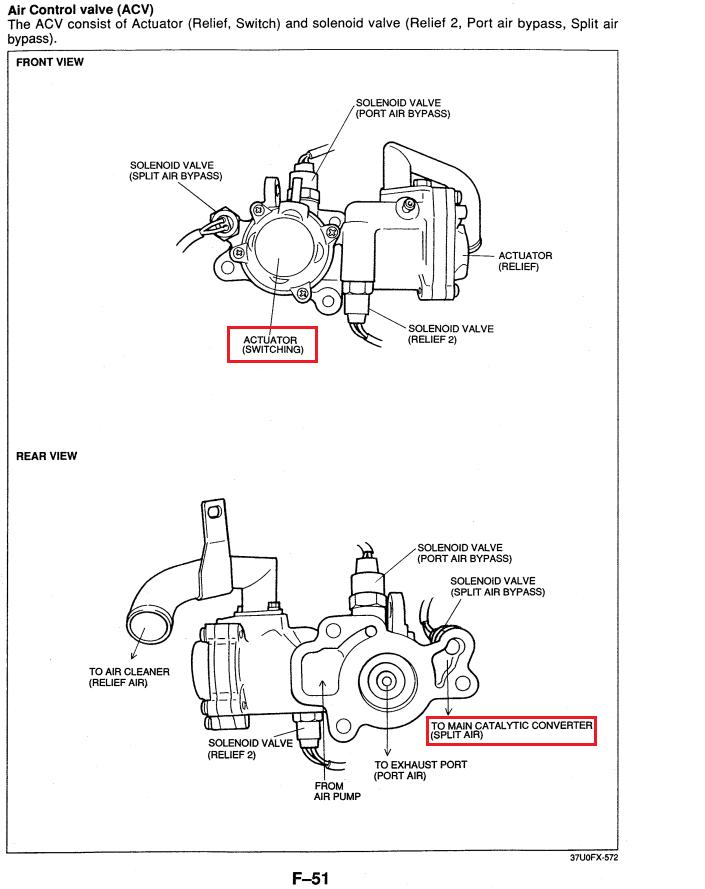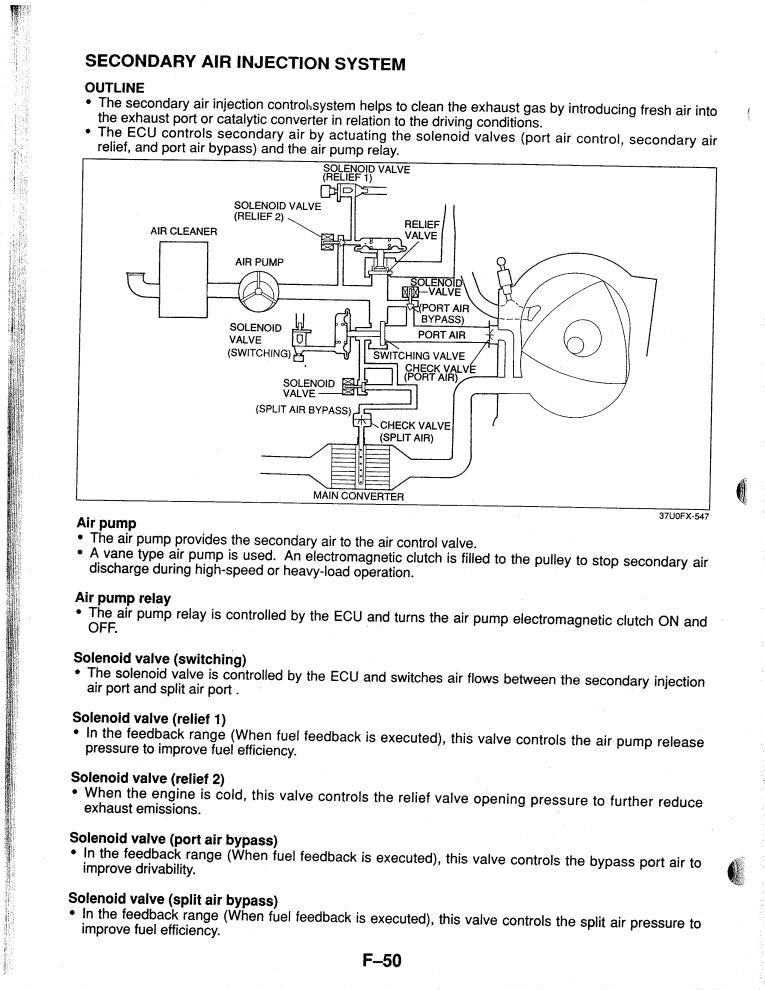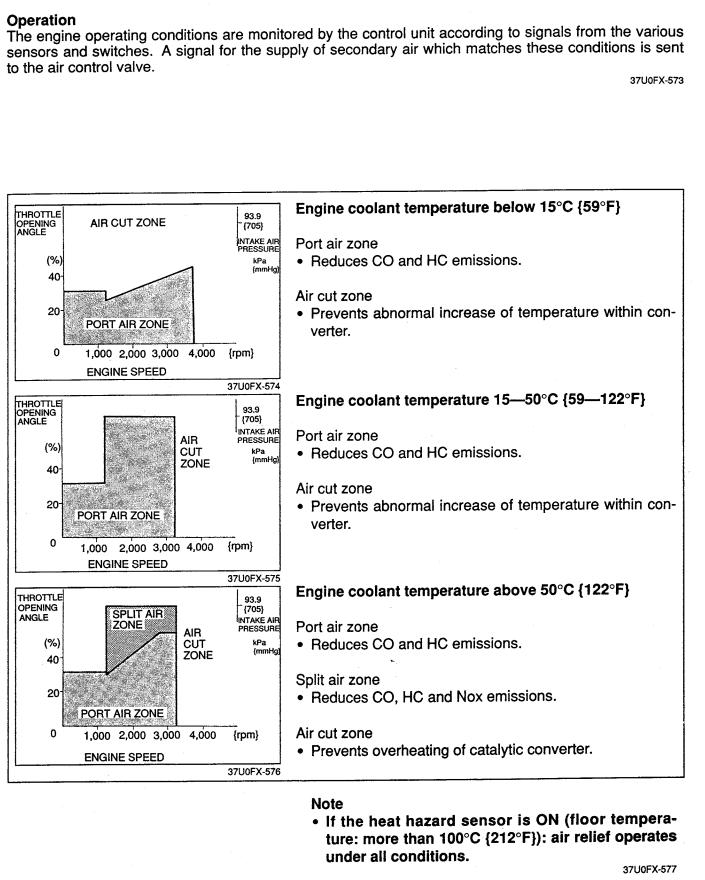Nonsequential... What's my ACV up to these days?
#1
Full Member
Thread Starter
Nonsequential... What's my ACV up to these days?
Previous owner did a full nonsequential mod on my car. But the air pump and ACV are both still installed and connected to the wiring harness. As you'd expect, however, the two vaccum ports on the ACV are capped off and the relevant solenoids are long gone. Car also has a PFC.
So where is the ACV sending the air pump air at this point? I figure possibilities are that it either:
1) Always goes to the exhaust port
2) Always goes to the split air hose
3) Always vents away from both, thus doing nothing
Thing is, from looking at a diagram I'm not sure what position the thing would "fail" into without the solenoids.
So where is the ACV sending the air pump air at this point? I figure possibilities are that it either:
1) Always goes to the exhaust port
2) Always goes to the split air hose
3) Always vents away from both, thus doing nothing
Thing is, from looking at a diagram I'm not sure what position the thing would "fail" into without the solenoids.
Last edited by msilvia; 10-09-15 at 10:06 AM.
#2
good thing I made a thread which talks about this
https://www.rx7club.com/3rd-generati...ntrols-841963/
https://www.rx7club.com/3rd-generati...ntrols-841963/
The switching actuator closes the passageway in the ACV that leads to the split air pipe (which goes to the cat). If no vacuum is applied to the switching actuator, air will always flow to the cat.


How the ACV Vacuum Lines and Solenoids work
As I started describing earlier, the switching and relief valves are operated by vacuum actuators. The switching valve directs air to either the exhaust ports (port air) or the cat (split air). With no vacuum applied to the actuator, the passage for port air is closed and the split air passage is open. When vacuum is applied to the switching actuator, the split air passageway closes and air flows to the exhaust ports.
The switching solenoid is, functionally speaking, an NO valve (Normally Open). When the switching solenoid is disengaged, vacuum flows to the switching actuator, and air is directed to the exhaust ports. When the switching valve is engaged (ECU applies ground to the coil), vacuum to the switching actuator is cut. With no vacuum applied to the switching actuator, air pump air is directed to the split air pipe and out to the cat.
The relief valve is just like a blowoff valve for the air pump. It relieves air injection pressure right before the air pump is de-clutched. The air pump is de-clutched for how speed operation and when the exhaust overheat warning comes on. The relief solenoid is an NC (Normally Closed) solenoid functionally equivalent to the charge control solenoid. When air injection pressure needs to be relieved (before de-clutching the air pump), the ECU switches a ground on the relief solenoid which allows engine vacuum to work on the relief valve actuator.

The split air bypass, port air bypass, and relief 2 solenoids are built into the ACV and require no vacuum lines. They are like recirculated blowoff valves (or the charge control valve) and are used to crudely control air injection pressure and volume. After looking over it, the ACV architecture is mostly unchanged from the older rotaries. The only thing that's different is the anti afterburn function, which in the FD is performed by ISC valve instead of the ACV like on the 2nd gen cars.
Secondary air injection control strategy:



How the ACV Vacuum Lines and Solenoids work
As I started describing earlier, the switching and relief valves are operated by vacuum actuators. The switching valve directs air to either the exhaust ports (port air) or the cat (split air). With no vacuum applied to the actuator, the passage for port air is closed and the split air passage is open. When vacuum is applied to the switching actuator, the split air passageway closes and air flows to the exhaust ports.
The switching solenoid is, functionally speaking, an NO valve (Normally Open). When the switching solenoid is disengaged, vacuum flows to the switching actuator, and air is directed to the exhaust ports. When the switching valve is engaged (ECU applies ground to the coil), vacuum to the switching actuator is cut. With no vacuum applied to the switching actuator, air pump air is directed to the split air pipe and out to the cat.
The relief valve is just like a blowoff valve for the air pump. It relieves air injection pressure right before the air pump is de-clutched. The air pump is de-clutched for how speed operation and when the exhaust overheat warning comes on. The relief solenoid is an NC (Normally Closed) solenoid functionally equivalent to the charge control solenoid. When air injection pressure needs to be relieved (before de-clutching the air pump), the ECU switches a ground on the relief solenoid which allows engine vacuum to work on the relief valve actuator.

The split air bypass, port air bypass, and relief 2 solenoids are built into the ACV and require no vacuum lines. They are like recirculated blowoff valves (or the charge control valve) and are used to crudely control air injection pressure and volume. After looking over it, the ACV architecture is mostly unchanged from the older rotaries. The only thing that's different is the anti afterburn function, which in the FD is performed by ISC valve instead of the ACV like on the 2nd gen cars.
Secondary air injection control strategy:

Last edited by arghx; 10-08-15 at 10:30 PM.
Thread
Thread Starter
Forum
Replies
Last Post


